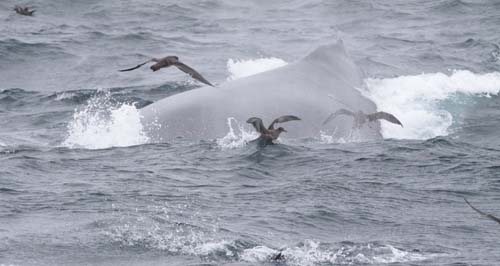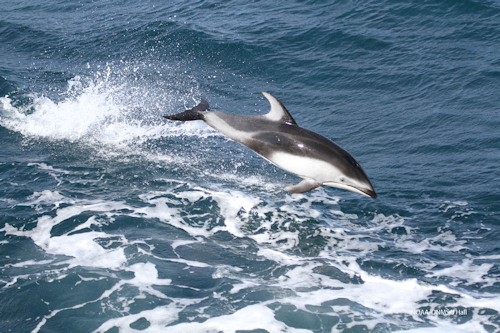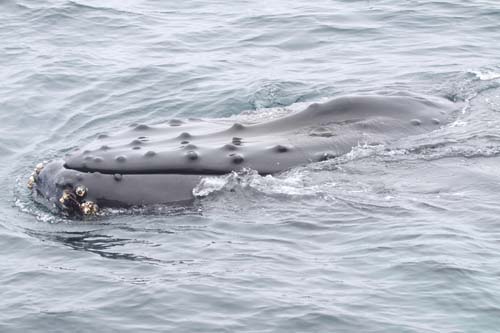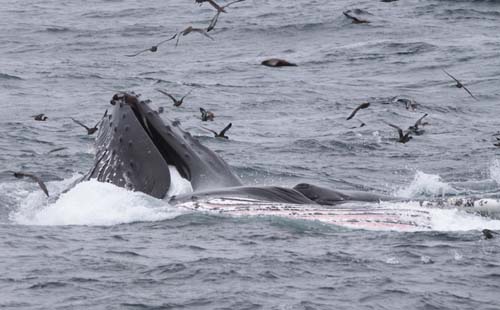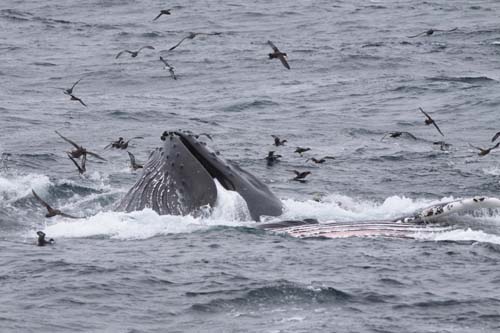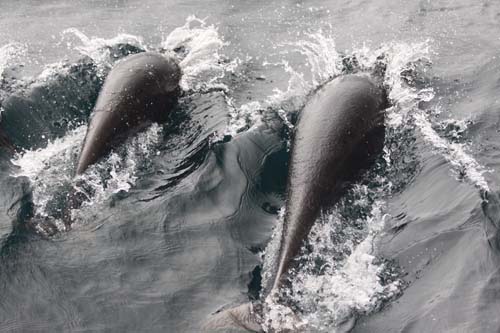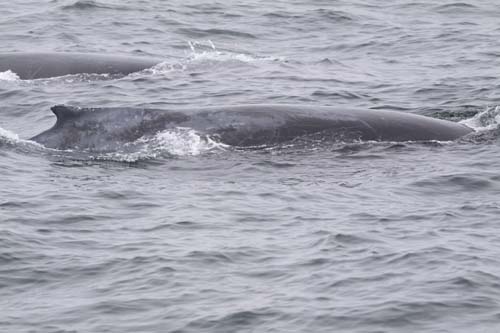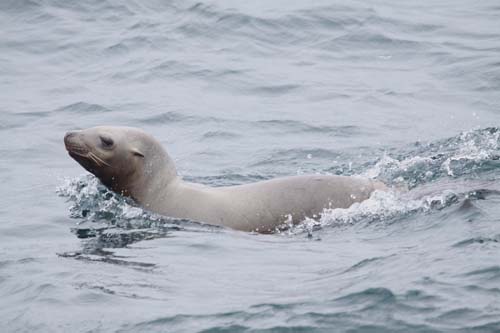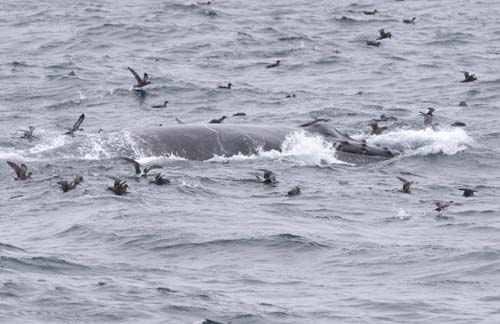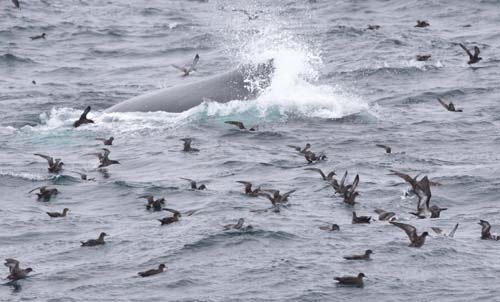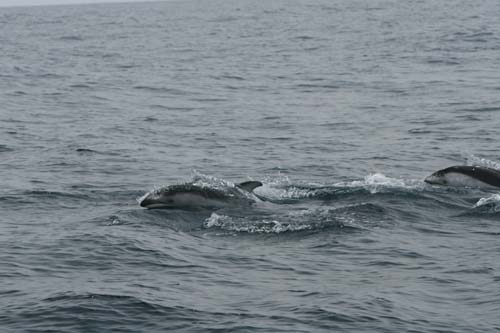Overview
Cordell Bank National Marine Sanctuary is known as a spectacular, yet challenging, destination for viewing marine wildlife – both seabirds and marine mammals. The challenge is due to its distance offshore as well as the rough ocean conditions often encountered.
The sanctuary has diverse and abundant marine mammal assemblages, including verified observations of 12 species of cetacean (whales, dolphins and porpoises) and five species of pinniped (seals and sea lions). For instance:
- Pacific white-sided dolphins are one of the most abundant marine mammals in the sanctuary.
- Other abundant cetaceans include Dall’s porpoises, which are often found in the company of northern right-whale dolphins.
- Humpback and blue whales are regularly seen in the summer and fall, when they visit the sanctuary to feed.
- California sea lions are one of the most abundant pinnipeds in the sanctuary. They are seasonally most abundant from the summer through early spring, when they are not in their breeding grounds on the Channel Islands and Año Nuevo.
- Other mammals include Risso’s dolphins, northern fur seals, northern elephant seals, Steller sea lions, harbor porpoises, minke whales and killer whales.
As with seabirds and fishes, the composition of the sanctuary’s marine mammal community is a mix of permanent and seasonal residents as well as species that use these waters for shorter periods – either as a feeding destination or in transit during long-distance migratory journeys.
California’s central coast is located on a migration pathway between northern feeding grounds and temperate and tropical breeding areas for many marine mammal species. For example, gray whales traverse these waters on their annual migrations between Arctic feeding grounds and Mexican breeding areas; however, in some years, many gray whales will also over-summer in the sanctuary to feed.
Blue and humpback whales are seasonally abundant, migrating into the sanctuary during late spring, summer and fall to feed in its productive waters. Northern fur seals and California sea lions are also seasonally abundant, coming here to forage during the fall through the spring. Smaller cetaceans (e.g., several dolphin and porpoise species) exhibit high variability in distribution, likely associated with local changes in oceanographic conditions and prey abundance.
Resident breeding pinnipeds include northern fur seals, Steller sea lions, harbor seals and northern elephant seals. A few California sea lions breed on the Farallon Islands. Cetaceans that likely breed in sanctuary waters include harbor porpoises and minke whales; cetaceans that have been seen with calves here include gray whales, humpback whales, Dall’s porpoises, Risso’s dolphins and Pacific white-sided dolphins.
The great productivity of sanctuary waters is caused by annual upwelling cycles that pull nutrients from deep-ocean environments into the water column, followed by relaxation periods when winds cease and surface waters warm. These nutrients are then consumed by planktonic organisms that support the entire food chain and make the sanctuary a rich feeding ground for many marine species.
Baleen whales, such as humpback and minke whales, feed mainly on krill and small schooling fishes, which are abundant within Cordell Bank’s upwelling-driven ecosystem. In contrast, toothed whales and pinnipeds feed mainly on fishes and squid here.
Sanctuary waters are important to several marine mammal species that are considered of special concern because of their reduced or declining populations. These population conditions may be the result of environmental change, habitat degradation, disease, human exploitation, interspecies competition or a combination of these factors. Of the marine mammals that are often found in the sanctuary, those that are considered special-status species (based on listings by state, federal and international agencies and organizations) include the humpback whale, blue whale, gray whale, northern fur seal and Steller sea lion.
Until recently, most of our understanding of marine mammals came from shore- and boat-based observations. New areas of study include documenting long-range migrations of animals that travel far from shore. These studies are enabled by satellite transmitters attached to pelagic seabirds, mammals, fishes, sharks and turtles.
Human impacts to marine mammal populations worldwide include competition for food with commercial and recreational fisheries, entanglement in fishing gear and other marine debris, disturbance and injury from ocean noise (including vessel traffic, human-generated middle-frequency sonar from military vessels and seismic surveys for oil and gas deposits), and injury or death from ship strikes. Toxins and ocean pollution could also be affecting the health of these animals. In addition, some species, such as the northern right whale, are still recovering from past harvesting or bycatch.
In addition to human impacts, changes in climate and oceanographic conditions affect marine mammals. The prevalence of these animals in sanctuary waters changes from year to year due to fluctuations in marine conditions, including El Niño, Pacific Decadal Oscillations and changes in intensity and timing of upwelling conditions in the spring/summer.
For example, the occurrence of blue whales within the central California region appears to be dependent on the timing and intensity of oceanographic upwelling conditions, which influence the abundance of krill (the primary prey of blue whales) within the area. In addition, variability in the distribution of delphinids (“ocean dolphins”) is related to ocean temperature changes.
Monitoring
Applied California Current Ecosystem Studies (ACCESS)
ACCESS is a research partnership to support integrated ocean management in northern and central California. Point Blue, Cordell Bank and Greater Farallones National Marine Sanctuaries have been investigating the spatial and temporal relationships between oceanographic processes, zooplankton, and marine birds and mammals in the region encompassing Cordell Bank and Greater Farallones national marine sanctuaries. This project has several objectives, including: 1) Understand how the timing, intensity, and duration of upwelling influences the distribution and abundance of euphausiids (better known as krill) thus affecting the distribution and abundance of krill predators in the region; 2) Identify persistent locations of predator and prey aggregations and potential areas of high trophic transfer in the Greater Farallones region that may be associated with bathymetric and hydrographic features; 3) Monitor physical and biological characteristics of the pelagic ecosystem, with the goal of developing indicators of ecosystem health, to understand change on a variety of scales and detect natural and anthropogenic impacts.
Research cruises have been conducted in spring, summer and fall (three to five cruises per year) from 2004 to the present. This study has shown large inter-seasonal and inter-annual differences in lower trophic level abundance as well as predator presence in the sanctuaries. This assessment of the pelagic system specifically meets the sanctuary’s mandate to conduct long-term monitoring of the resources within the sanctuary and provides important information for resource protection and management.
CSCAPE: Collaborative Survey of Cetacean Abundance and the Pelagic Ecosystem
CSCAPE was a collaboration between the National Oceanic and Atmospheric Administration (NOAA) Fisheries and the National Marine Sanctuary Program to assess the abundance and distribution of marine mammals and characterize the pelagic ecosystem off the U.S. West Coast. Cruises were conducted every three years and cover the entire West Coast, from the northern boundary of Washington to the southern boundary of California, including concentrated sampling within the West Coast sanctuaries.
The project had three objectives:
- to conduct a marine mammal assessment survey within approximately 300 nautical miles of the shore, with additional fine-scale surveys within the sanctuary boundaries
- to characterize the pelagic ecosystem within the study area through the collection of underway and station-based biological and oceanographic data, seabird studies and acoustic sampling
- to conduct biopsy sampling and photo-identification studies of special-interest species
Cordell Bank Ocean Monitoring Program
The Cordell Bank Ocean Monitoring Program (CBOMP) collected information on the spatial and temporal variability in the oceanographic system of the Cordell Bank region from 2004 to 2010. Data on the abundance of seabirds, marine mammals, other vertebrates and marine debris were collected by trained observers along six 12-kilometer east-west transects centered on Cordell Bank. Physical and biological characteristics of the pelagic system were measured along transects using a CTD (vertical profiles of salinity, temperature, chlorophyll-a, and light levels at set stations), TSG (continuous surface values of salinity, temperature, chlorophyll-a) and echo sounder (continuous measurements of relative abundance of zooplankton).
Starting in 2010, CBOMP was replaced by the Applied California Current Ecosystem Studies (ACCESS) program.
Tagging of Pacific Pelagics (TOPP)
A pilot program of the Census of Marine Life, the Tagging of Pacific Pelagics (TOPP) research project is part of an international endeavor to determine what lives in the world’s ocean. TOPP scientists explore the Pacific using satellite-tagged animals to gather data about their world. The results coming from these satellite-based research projects are expanding our understanding of marine wildlife and the role of the sanctuary in their feeding and migratory patterns. Marine mammals that are tagged as part of the TOPP program include elephant seals, California sea lions, blue whales, humpback whales, fin whales and sperm whales.
Photos
Maps
Projects
ACCESS - Applied California Current Ecosystem Studies
The Applied California Current Ecosystem Studies (ACCESS) is a partnership that supports marine wildlife conservation and healthy marine ecosystems in northern and central California by conducting ocean research to inform resource managers, policy makers and conservation partners.
California Cooperative Oceanic Fisheries Investigations (CalCOFI)
The California Cooperative Oceanic Fisheries Investigations (CalCOFI) was formed in 1949 to study the ecological aspects of the Pacific sardine population collapse off California. Today, the focus has shifted to the study of the marine environment off the coast of California, the management of its living resources, and monitoring the indicators of El Nino and climate change.
Cordell Bank Ocean Monitoring Program
The goal of the Cordell Bank Ocean Monitoring Program (CBOMP) is to characterize and monitor the spatial and temporal variability in the physical and biological components of the pelagic ecosystem in the region surrounding Cordell Bank. In addition, these data can be integrated with regional ocean observing programs to understand changes in the central California ocean environment. Monthly cruises (sometimes seasonally) were conducted from 2004-2010.CSCAPE: Collaborative Survey of Cetacean Abundance and the Pelagic Ecosystem.
CSCAPE is a collaboration between the National Marine Fisheries Service and the National Marine Sanctuary Program to assess the abundance and distribution of marine mammals and to characterize the pelagic ecosystem out to ~300 nautical miles off the U.S. West Coast.Monitoring whales by Cascadia Research Collective
Cascadia Research is a non-profit (501c3) scientific and education organization based in Olympia, Washington, USA. We primarily conduct research needed to manage and protect threatened marine mammals.Tagging of Pacific Predators (TOPP)
The Tagging of Pacific Pelagics (TOPP) research program aims to understand the migration patterns of large predators in the North Pacific basin and how these animals act and interact in their open ocean habitats. By using satellite tagging techniques, TOPP researchers follow the movements of different species across multiple trophic levels (i.e., the food web) and in relation to physical oceanographic features in order to piece together a whole ecosystem picture.Links
Año Nuevo State Park - Northern Elephant Seals
California State Parks website for Año Nuevo, the site of the largest mainland breeding colony in the world for the northern elephant seal.http://www.parks.ca.gov/default.asp?page_id=523
American Cetacean Society - Monterey Bay Chapter
Find out more about what the local chapter of the American Cetacean Society does to expand scientific knowledge of these fascinating creatures.http://www.acsmb.org/
David's Whale and Dolphin Watch
Image library with many whale and dolphin images, organzied by species. Site also provides links to other pages.http://neptune.atlantis-intl.com/dolphins/index.html
Defenders of Wildlife - Sea Otter educational unit
This unit focuses on sea otters of California, Oregon, and Washington and is available in English and Spanish.http://www.kidsplanet.org/espanol/espint.html
Discovery of Sound in the Sea
This web site will introduce you to the science and uses of sound in marine research.http://omp.gso.uri.edu/dosits/dosits.htm
Lawrence Hall of Science (UC Berkeley) - Whale Sounds
Online whale sound activity that includes recorded whale sounds and discusses communication and echolocation, the term that describes how many marine mammals "see with sound" underwater.http://lhs.berkeley.edu/WHALE
List of links provided by SeaWorld
SeaWorld and Walt Disney World provide a list of links with Orca information.http://www.orlandofuntickets.com/the-sea-life-of-orca-whales.php
List of Marine Mammal Species and Subspecies
The Ad-Hoc Committee on Taxonomy, chaired by Bill Perrin, has produced the first official Society of Marine Mammology list of marine mammal species and subspecies. Consensus on some issues was not possible; this is reflected in the footnotes.http://www.marinemammalscience.org/index.php?option=com_content&view=article&id=420&Itemid=280
MARE: Marine Activities, Resources and Education
MARE is an interdisciplinary science program at the Lawrence Hall of Science (UC Berkeley) offering year-round professional development opportunities, including events that immerse your whole school—faculty, students and families—in the study and celebration of the ocean.http://www.lawrencehallofscience.org/MARE/
Monterey Bay Aquarium - Student and Teacher Resources and Activities
The Monterey Bay Aquarium offers teacher and student resources including: species and habitat-specific information, live cams, classroom activities, and interactive online games.http://www.mbayaq.org/lc/
Monterey Bay National Marine Sanctuary - Marine Mammals
A comprehensive and educational scientific characterization of important creatures in the Monterey Bay Sanctuary.http://montereybay.noaa.gov/sitechar/mamm.html
Monterey Bay National Marine Sanctuary - Slideshow
Slideshow that includes photos of landscapes, marine mammals, birds and other organisms found in the Monterey Bay.http://montereybay.noaa.gov/visitor/slideshow/slideshow.html
Monterey Bay Whale Watch - Marine Life of the Bay
Photos and brief descriptions about local marine mammals and other marine wildlife from the Monterey Bay.http://www.montereybaywhalewatch.com/marlife.htm
Monterey Bay Whale Watch - Marine Mammal Sightings in the Monterey Bay Region
View a list of the most recent marine mammal sightings logged by Monterey Bay Whale Watch. This list is constantly updated.http://www.montereybaywhalewatch.com/sighting.htm
National Marine Mammal Laboratory
The National Marine Mammal Laboratory (NMML) conducts research on marine mammals worldwide, concentrating primarily in coastal California, Oregon, Washington and Alaska.http://nmml.afsc.noaa.gov/
NOAA National Marine Mammal Laboratory
Marine Mammal Education Web hosted by NOAA's Alaska Fisheries Science Center.http://www.afsc.noaa.gov/nmml/education/marinemammals.php
NOAA Photo Library
NOAA's photo library contains incredible shots of an amazing array of animals, technology, scientists, and images of historical treasures. Site also offers search function for images.http://www.photolib.noaa.gov
OBIS-SEAMAP: Ocean Biological Information System - Spatial Ecological Analysis of Megavertebrate Populations
A digital database of marine mammal, seabird, and sea turtle distribution and abundance. The web-based system will allow the interactive display, query, and analysis of the digital archive in conjunction with environmental data.http://seamap.env.duke.edu/
Save the Whales
Save The Whales is a non-profit organization whose mission is to educate children and adults about marine mammals, their environment and their preservation. Save the Whales is based in Monterey, and their website provides information on free class presentations, Adopt-A-Whale programs and general information about local marine mammals.http://savethewhales.org
SLEWTHS: Science Learning and Experimenting with the Help of Sea Lions
Research project that studies marine mammals, with sea lions and people working together. Sponsored by Moss Landing Marine Lab, the program also offers classes, internships and other learning opportunities.http://slewths.mlml.calstate.edu/
SORAC: Sea Otter Research and Conservation
Find out what the Monterey Bay Aquarium is doing to learn more about how to conserve the California sea otter.http://www.mbayaq.org/cr/sorac.asp
Tagging of Pacific Predators: near real-time animal tracks
Images of near real-time satellite tracking data of pelagic species of sharks, mammals, and turtles.http://topp.org/
The Marine Mammal Center
Learn more about an organization that rescues, rehabilitates, releases, teaches about and researches marine mammals.http://www.marinemammalcenter.org/
The Otter Project
The Otter Project exists to promote the rapid recovery of the California sea otter, an indicator of near shore ocean health, by facilitating research and communicating research results to the general public and policy makers.http://www.otterproject.org
USGS Western Ecological Research Center - Sea Otter Research
The U.S. Geological Survey Western Ecological Research Center (USGS WERC) maintains expertise on sea otters in California, Washington, and Alaska, and works with state, federal, and local partners throughout the species' range. The Center, located in Santa Cruz, is the repository for data on both the threatened California sea otter population and the state-listed Washington sea otter population.http://www.werc.usgs.gov/project.aspx?projectid=91
Whale Acoustics
A company that works with federal agencies to study man-made noise impacts on whales and the use of passive acoustics to develop census methods for whales.http://www.whaleacoustics.com
Whale sightings by Sanctuary Cruises
The Captain's log is the latest in whale sightings information in Monterey Bay as collected by Sanctuary Cruises.https://sanctuarycruises.com/captains_log/
WhaleNet
WhaleNet is an interdisciplinary, student-centered, interactive educational program focused on whales, the marine habitat, and environmental studies. Some activities are available on-line, some can be ordered for an additional charge.http://whale.wheelock.edu/Welcome.html
WhaleNet Guide to Whales & Marine Mammals of the North Atlantic Ocean
CDROM with educational materials on Marine Mammals of the North Atlantic.http://whale.wheelock.edu/whalenet-stuff/CDROMintro.html
